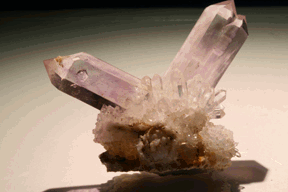A free gemology reference site
Gemology, gemstones, minerals and more
The Gemstones
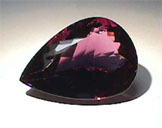 Amethyst
Amethyst
What color is it?: As you can
see from the photos at top and left, amethyst can change color
in different lighting environments. The top photo was taken in
halogen light while the photo at left in fluorescent light. But
in general amethyst will run from purple to violet and a wide
variety of combinations in between.
What is the story
behind this gemstone?: The
ancient Greeks believed that wearing an amethyst would keep the
wearer from becoming drunk. I am not sure how long it took them
to decide differently. But I can tell you that I knew a lot of
Greeks (fraternity guys that is) who wore an amethyst class ring
when I was in college and believe me, it didn't work. Amethyst
is a member of the quartz family along with citrine, chalcedony
and several others.
Can I wear it everyday?: Absolutely. Amethyst is one of the best wearing gemstones there is.

An amethyst
"bowl" measuring over 4 feet from Brazil
Is it expensive?: Generally no. But you should
look for an amethyst that has red flashes as you rotate the stone.
The finest will have a deep purple color and flash red when rotated.
These can run as high as US$100.00 per carat. But generally the
stone is very affordable considering the beauty it delivers.
Is it a birthstone?: February
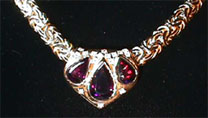 What do I need to know before
going shopping?: As
you will note from the page on synthetics, there is a lot of
synthetic amethyst on the market. And it is very difficult to
identify...even for experienced, well trained gemologists. Best
bet is to stay with a long established, professional independent
jeweler with a trained gemologist on staff. And...get it in writing
on your receipt that the stone is natural and not synthetic.
Then if you do have a problem you are legally covered for any
action you may need to take.
What do I need to know before
going shopping?: As
you will note from the page on synthetics, there is a lot of
synthetic amethyst on the market. And it is very difficult to
identify...even for experienced, well trained gemologists. Best
bet is to stay with a long established, professional independent
jeweler with a trained gemologist on staff. And...get it in writing
on your receipt that the stone is natural and not synthetic.
Then if you do have a problem you are legally covered for any
action you may need to take.
Natural amethyst crystals with perfect termination
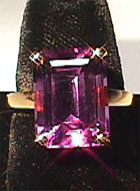
 General Information
General Information
Source: The Jacobina Mine in Brazil
is famous as the best source. But there are others in various
parts of the world. However, as shown by the faceted 10.00ct
amethyst ring and the huge amethyst cathedrals from Brazil shown
above, you can see why Brazil is the finest source of amethyst.
Chemical: SiO2
Formation: Pegmatite dikes and hydrothermal
environments
Crystal System: Trigonal
Unusual Properties: None but many possible formations
such as ametrine which is a combination of two types of quartz
that form in the same crystal.
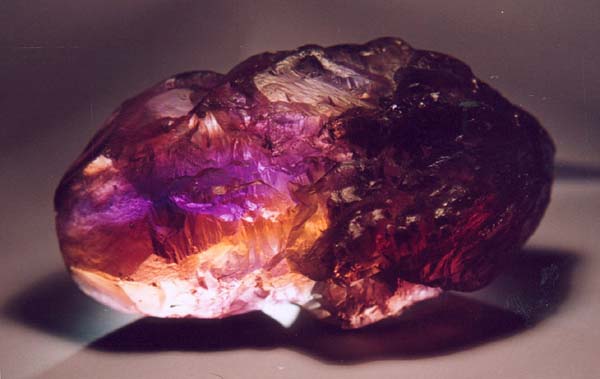 Ametrine rough showing citrine
and amethyst zones
Ametrine rough showing citrine
and amethyst zones
Gemological information on this page has been provided by the

